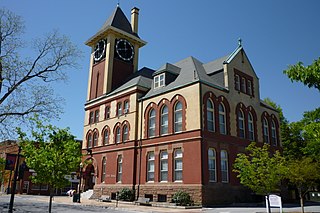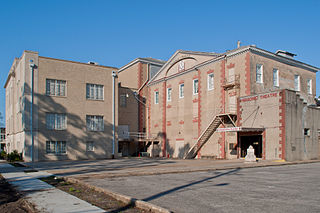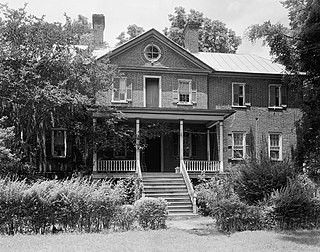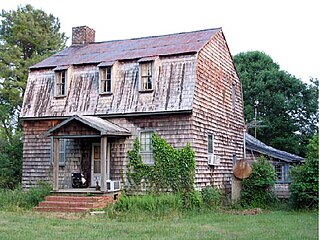
New Bern is a city in and the county seat of Craven County, North Carolina, United States. At the 2020 census, it had a population of 31,291. It is located at the confluence of the Neuse and the Trent rivers, near the headwaters of Pamlico Sound on the North Carolina coast. It lies 112 miles (180 km) east of Raleigh, 89 miles (143 km) north of Wilmington, and 162 miles (261 km) south of Norfolk.

Drayton Hall is an 18th-century plantation house located on the Ashley River about 15 miles (24 km) northwest of Charleston, South Carolina, and directly across the Ashley River from North Charleston, west of the Ashley in the Lowcountry. An example of Palladian architecture in North America and the only plantation house on the Ashley River to survive intact through both the Revolutionary and Civil wars, it is a National Historic Landmark.

Boone Hall Plantation is a historic district located in Mount Pleasant, Charleston County, South Carolina, United States and listed on the National Register of Historic Places. The plantation is one of America's oldest plantations still in operation, as it has continually produced agricultural crops for over 320 years. The majority of this labor, as well as the construction of the buildings and its characteristic bricks, was performed by enslaved African Americans, aside from the main building, which was built in 1936. For this reason, the site was named one of the African American Historic Places in South Carolina in 2009. The historic district includes a 1936 Colonial Revival-style dwelling, and multiple significant landscape features, including an allée of southern live oak trees, believed to have been planted in 1743. The site is open for public tours.

The Mordecai House, built in 1785, is a registered historical landmark and museum in Raleigh, North Carolina that is the centerpiece of Mordecai Historic Park, adjacent to the Historic Oakwood neighborhood. It is the oldest residence in Raleigh on its original foundation. In addition to the house, the Park includes the birthplace and childhood home of President Andrew Johnson, the Ellen Mordecai Garden, the Badger-Iredell Law Office, Allen Kitchen and St. Mark's Chapel, a popular site for weddings. It is located in the Mordecai Place Historic District.

This list includes properties and districts listed on the National Register of Historic Places in Craven County, North Carolina. Click the "Map of all coordinates" link to the right to view an online map of all properties and districts with latitude and longitude coordinates in the table below.

The Masonic Temple, the home of Saint John's Lodge No. 3, A.F. & A.M., is a historic Masonic temple and theatre located at 516 Hancock Street in New Bern, Craven County, North Carolina. It was built between 1802 and 1809, with additions and several alterations. The original section is a very tall, two-story Federal style brick structure, seven bays wide by four bays deep. It sits on a high basement and has a hipped roof. A major addition was made in 1904, and the building was remodeled in 1847 and in 1917. The site was the scene of a duel in 1802.

St. Thomas Episcopal Church is a historic church on Craven Street in Bath, North Carolina. The church building was constructed in 1734 and is the oldest surviving church building in North Carolina. It is a Flemish bond brick structure.

Saint Paul Catholic Church is a Catholic parish in New Bern, North Carolina, within the jurisdiction of the Diocese of Raleigh. Its Main Campus is located at 3005 Country Club Rd. Its historic parish church is located at 504 Middle Street. Although most Masses are held at the main campus, the parish continues to celebrate Friday Mass at 8 a.m. at the historic church. The parish also hosts a parochial school, St. Paul Catholic School.

St. Peter's AME Zion Church is a historic African Methodist Episcopal church located at 615 Queen Street in New Bern, Craven County, North Carolina. It was built between 1923 and 1942, on the site of the 1914 church building which was destroyed by fire in 1922. It is a large three bay by seven bay, rectangular brick church building in the Late Gothic Revival style. It features a gabled nave flanked by two-story truncated stair towers. Also on the property is the contributing 1926 parsonage; a 2+1⁄2-story, frame American Craftsman style dwelling. It is known within the denomination as the "Mother Church of Zion Methodism in the South," and the oldest existing African Methodist Episcopal congregation in the South.

Botany Bay Heritage Preserve & Wildlife Management Area is a state preserve on Edisto Island, South Carolina. Botany Bay Plantation was formed in the 1930s from the merger of the Colonial-era Sea Cloud Plantation and Bleak Hall Plantation. In 1977, it was bequeathed to the state as a wildlife preserve; it was opened to the public in 2008. The preserve includes a number of registered historic sites, including two listed in the National Register of Historic Places: a set of three surviving 1840s outbuildings from Bleak Hall Plantation, and the prehistoric Fig Island shell rings.
King-Freeman-Speight House, also known as Francis Speight House, is a historic plantation house located at Republican, Bertie County, North Carolina. It was built in two sections, with the oldest built between 1808 and 1828. The older section forms the basis of the current rear wing. About 1828, a 2+1⁄2-story, Federal style, side-hall plan was added at a right angle to the original structure. The house was enlarged and remodeled in 1907. It has a two-story, two-bay addition and a two-story rear addition built in 1855. It features a hip roof front porch. Also on the property are the contributing two smokehouses, the kitchen, and an office. Noted landscape artist Francis Speight was born in the house in 1896.

Bellair is a historic plantation house located near New Bern, Craven County, North Carolina. It was built about 1792, and is a two-story, seven-bay, central hall plan Georgian style brick dwelling. It sits on a high basement and has a three-bay, central projecting pavilion.

Jones–Jarvis House, also known as General Foster's Headquarters and Jarvis–Slover House, is a historic home located at New Bern, Craven County, North Carolina. It was built about 1810, and is a 2+1⁄2-story, three-bay, side-hall plan, Federal-style brick dwelling. It has a one-story brick and frame rear wing. During the American Civil War, General John G. Foster moved into this house, and it served first as his residence and later as part of the headquarters of the Eighteenth Army Corps.

Isaac Taylor House, also known as the Taylor-Ward House, is a historic home located at New Bern, Craven County, North Carolina. It was built about 1796, and is a three-story, three-bay, side hall plan Federal-style Flemish bond brick dwelling.

Shemuel Kearney House was a historic plantation house located near Franklinton, Franklin County, North Carolina, formerly at 2555 U.S. Highway 1 south of town. In 2009, the house was dismantled and moved to nearby Louisburg for restoration as the original property was recently zoned by Franklin County for commercial use. Therefore, the building had to be relocated. The Shemuel Kearney House was reconstructed next to another historic residence, the Cooke House, on Peach Orchard Road in 2015.

Green River Plantation is a historic plantation house on over 360 acres located near Columbus, Polk County, North Carolina. The oldest section of the "Big House" was built between the years 1804–1807, and is a two-story, four-bay, Late Federal style frame dwelling. A later two-story, four-bay, brick Greek Revival style dwelling was built beside the original structure in the mid-19th century. The two sections were joined in the late 19th century by a two-story section and grand staircase to form a structure that is over 10,000 square feet in size and boasts over 42 rooms and spaces. The plantation house was built by Joseph McDowell Carson, son of Col. John Carson, who built Carson House at Marion, North Carolina. The later-built section of the home was the residence of Samuel Price Carson, North Carolina State Senator and U.S. Federal Representative, and younger brother of Joseph McDowell Carson.
Mount Vernon is a historic plantation house, farm complex, and national historic district located near Woodleaf, in Scotch Irish Township, Rowan County, North Carolina. The house was built about 1822, and is a two-story, three-bay, Federal style frame dwelling. It is sheathed in weatherboard and has a full-width, one-story shed roofed porch. The house was designated a post office in 1822. Also on the property are the contributing log smokehouse, large barn, "lighthouse" or Delco house, corn crib, gear house, woodhouse, spring house, mill site, shop, and plantation office.
Purefoy–Dunn Plantation is a historic plantation and national historic district located near Wake Forest, Wake County, North Carolina. The Greek Revival style plantation house was built about 1814 and remodeled about 1850. It is a two-story, L-shaped, heavy timber frame building. It has a low hipped roof and is sheathed in clapboards. The front portico was removed in the 1960s or early 1970s. Also on the property is a contributing mid-19th century gable-roofed frame smokehouse.



















